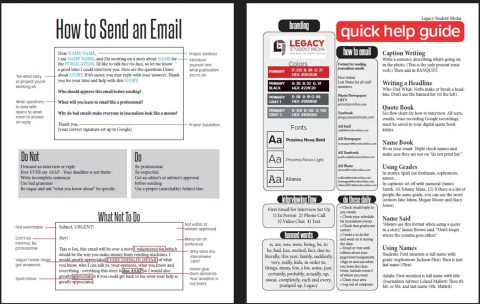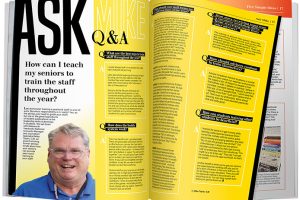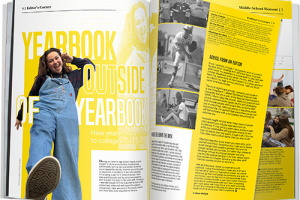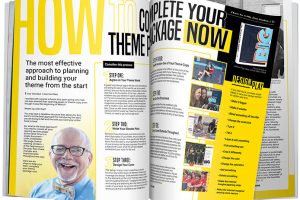
23 Lessons To Get Your Staff Started On Your 2023 Book
No matter where you are in your career, the first weeks of school usually don’t go as planned. There are schedule changes, class meetings, required readings, equipment distribution and so much more that cause disruptions to the flow you hope to establish. I’ve learned to have lessons ready that prepare my yearbook staff for the year but also won’t cause a commotion if they miss out on some of the instruction.
The other problem we all face as publication advisers: How do we grade things? Here’s a back-to-school list of gradable activities that will help jump start your staff for the amazing book they are about to produce.
BELL RINGERS AND OPENERS
1.Storytelling with good verbs. This activity is fun the first day. Never start day one with rules and guidelines. Your students hear those all day long. Pair up students. Give them a question to ask each other. For example, “What was the best thing you did this summer?” One partner answers. The one asking will buzz, yell or beep out loud when the storyteller uses a bad verb. Write each of these on the board.
- IS
- WERE
- BEEN
- ARE
- BE
- HAS
- WAS
- BEING
- HAVE
After a few minutes ask another question. Change partners as needed. This exercise prepares students for good writing on day one.
2.Word cemetery wall. You’ve already started with the list above, but discuss which words are bland, overused or boring. Look at last year’s book and see what words you should bury. My guess is words like: excited, decided to, family, many, a lot, get and various others will go on the list fast. Print these out and dedicate a wall for the dead words that will not appear in the 2023 book.
3. Better verbs list. Have students select an index card with a bland verb (walk, talk, run, went, see, go, play) and instruct them to brainstorm words that better describe that word. For example, glide, march and trudge are all better descriptors of walk. Students can roam the room and ask for suggestions.
4. Theme words. If you have your theme selected, create a word and phrase list with your theme words. This list can be posted around the room. It becomes a resource for caption starters, writing stories and verbs throughout the book. For bonus points, your staff can create a list of phrases that describe what your theme means.
BACK TO THE BASICS
For these projects, you could pair up an experienced staff member with a new staff member. Depending on how long you want to stretch this project out, you could assign each pair one of these or just one per group. Have the pair create an instructional infographic on the basics of the topics below. Select the best and post them around the classroom or add them to staff binders for reminders and quick how-tos.
5. Basic design
6. Intro to photography
7. How to write a caption
8. How to interview
9. How and where to save flies

POLICY AND PROCEDURES
10. How to email. Don’t laugh. A lot of students don’t know how to send a proper email. Take the time to show them how a professional email reads. Talk about CC, BCC, signatures and especially reply to all.
11. Create or update a staff policy guide. If you’re starting from scratch, don’t. Ask for examples from other staffs to borrow and mold them into a policy that works for your school and classroom. It’s also important to get an administrator to take part in this process somehow. If you have a policy guide in place, continue to update it each year. Some important aspects to include in your policy guide are:
- Purpose/Audience
- Advertising policy
- Refund policy
- Death policy (how you cover a student death)
- Staff expectations and discipline
- Use of equipment
- Social media guidelines for your publication staff account
- Scholarship requirements (if you give scholarships)
12. Job descriptions. It’s important from the beginning of the year to know what the EIC does. What duties does the copy editor have? List who does what, when and how. Work through and update this document with the whole staff. This could cut down on drama later in the year.
13. Quick reference guide. This guide can be displayed throughout the room for simple reminders on how to do day-to-day things. Make it a contest to see who can design the best guide.
PLAN THE BOOK
14. Page planning. Use a page-planning tool for your staff to plan what will go on each page. Depending on the organization and theme of your book, you can guide your staff on what coverage is needed.
15. Marketing/Sales campaign. Group your staff in two or three and have them create a full presentation on how you will sell the book this year. It needs to match the theme in some way. The campaign should include visuals, tag line, flyers, mailers and other materials. Each group must dress professionally and present in front of the class. Bring in judges to select the best campaign. Use it all year.
16. Ad sales campaign. Use the same approach as your marketing/sales campaign, but tailor this approach to ad sales for parents and businesses. Have groups present on how they will successfully sell ads in the book.
17. Inspiration search. Once the theme is selected, have students look for design inspiration. Use graphic design websites, magazines, college brochures, ads and image searches for ideas. Break up the ideas into groups – spread ideas, quick reads, fonts, coverage, etc. Grade on how many each student finds and saves to the shared folder.
18. Theme package. Maybe you don’t have a theme. Have each student or groups create a theme package. Use Mike Taylor’s theme challenge PowerPoint and guide each group to create a cover, endsheet, title page, division page, sample layouts, theme copy, color pallet and font package. They’ll present it before the class. Scan this QR code to download.
WRITING
19. Grammar enrichment. Create a account. Your students will sign up under your class and select their favorite movies, TV shows, celebrities and pop culture items that the system will build sentences from. You’ll select from a plethora of lessons from nouns to active/passive voice. The best part is the system grades for you!
20. Gather quotes. This assignment is more homework than classwork. Have students collect quotable quotes throughout the day (week or year) in other classes or organizations. These quotes could be used in different locations in the book or for filler if needed.
21. Write a Q&A story. Pull some examples from teen magazines of question/answer stories. These stories can be fun and laid back. The story should focus on a person. Again, store these up for the index or class pages when you have some empty space.
22. Copyrights and plagiarism. The SPLC website ( ) has an abundance of resources on these topics. There are lesson plans and PowerPoints you can download for free.
GIVE BACK
23. Community service. Community service plays a big part in team-building and helps with the college resume. Create a Google Doc and have students research places or organizations your class could donate time or resources to. Students should also use their new-found emailing skills to contact these organizations about helping and donating time. Include on the Google Doc a contact name, phone number, address and when the organization was contacted. Aim to have one project a month.
These ideas can help you prep for the unexpected and keep your class running smoothly. You can add your own ideas to this list and adjust the lessons to fit your unique needs. Continue to add to this list each year to help the beginning of the school year be a productive time of learning for your students.
Can I Quote You on That? A first interview can be intimidating for even the best of students. This flow chart provided the order of methods a student should use to reach out to another individual for an interview. It also specified whereto save the flies after the interview. Courtesy of Legacy Student Media



